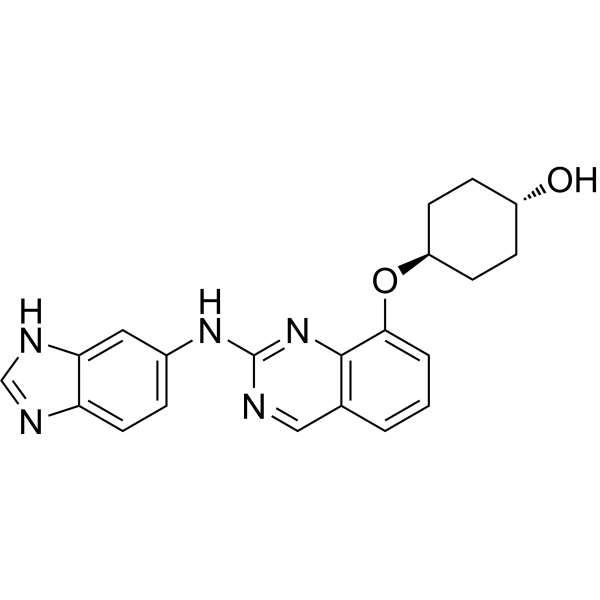
| 规格 | 价格 | ||
|---|---|---|---|
| 500mg | |||
| 1g | |||
| Other Sizes |
| 靶点 |
TNIK 21 nM (IC50)
|
|---|---|
| 体外研究 (In Vitro) |
一种新型TNIK抑制剂的发现[1]
在确认了靶向TNIK的安全性和可行性后,我们筛选了一个以激酶为中心的内部化合物库,并鉴定了一系列具有高TNIK酶抑制活性的喹唑啉类似物。随后的先导优化导致NCB-0846[顺式-4-(2-(3H-苯并[d]咪唑-5-基氨基)喹唑啉-8-基氧基)环己醇]的鉴定(图2a,左)。构效关系分析表明,环己烷部分手性末端羟基的立体化学对TNIK酶的抑制很重要。NCB-0846对TNIK显示出抑制活性,半数最大抑制浓度(IC50)值为21 nM(图2b),但其末端羟基结构相反的非对映异构体(命名为NCB-0970)(图2a,右)显示TNIK抑制活性低13倍(IC50=272 nM)(图2b)。NCB-0846还抑制FLT3、JAK3、PDGFRα、TRKA、CDK2/CycA2和HGK(0.1时>80% μM;补充表1)。NCB-0970对人激酶组显示出类似的抑制作用,除了STE20成员激酶,包括TNIK(图2c)。基于这些结果,我们使用NCB-0970作为TNIK抑制的阴性对照。 NCB-0846抑制癌症细胞体外生长[1] 在常规二维(2D)培养条件下,NCB-0846对HCT116细胞的细胞生长抑制活性是NCB-0970的6.8倍(图3a)。同时,与NCB-0970相比,NCB-0846在软琼脂中对相同细胞的集落形成表现出更高的抑制活性(约20倍)(图3b),表明该化合物对癌症细胞的克隆原性具有更强的活性。 TNIK抑制消除结直肠癌癌症干性[1] 主动Wnt信号传导与CSC功能有关。NCB-0846,而非NCB-0970,下调了推定的结直肠CSC标志物CD44、CD133和醛脱氢酶1(ALDH1)30,31的表达(图5a,左)。流式细胞术分析显示,NCB-0846降低了CSC表面标志物(CD44、CD133、CD166、CD29和EpCAM)高表达和ALDH活性(图5b)的细胞比例(补充图7)。CSCs通常表现出上皮间质转化(EMT)表型32。NCB-0846还降低了间充质标记物(Slug、Snail、Twist、Smad2和波形蛋白;图5a,右)的表达。然而,胚胎干细胞标记物(Oct4、Nanog和Sox2)33没有受到影响(图5a,右),表明TNIK调节了肠上皮细胞的干度。 |
| 体内研究 (In Vivo) |
最后,我们探讨了NCB-0846的EMT抑制活性是否影响转移。在NCB-0846或NCB-0970存在或不存在的情况下,用TGFβ1处理A549细胞48小时 h,然后通过尾静脉注射到免疫缺陷小鼠体内(每组8只)。注射七周后,处死小鼠,在组织切片中对其肺转移进行数字定量(图5a)。该动物实验主要用于评估全身注射后立即栓塞在外周肺血管中的癌症细胞的经内皮迁移/外渗能力。
在注射TGFβ1处理的细胞的小鼠中,转移性病变占肺面积的38%,但差异显著(P < 0.001) 注射NCB-0846处理的细胞的小鼠肺部减少(图5b)。我们通过组织切片的显微镜检查证实完全没有转移。同时,与注射过DMSO(对照组)或NCB-0970细胞的小鼠相比,注射过NCB-0846处理细胞的小鼠的平均肺重量因缺乏肺转移负荷而显著降低(图5c)。这些结果支持NCB-0846对EMT的抑制损害了TGFβ1诱导的肺癌细胞转移潜能的观点[2]。
|
| 酶活实验 |
迁移率变化分析[1]
使用QuickScout筛选辅助试剂盒通过迁移率变化分析52测量TNIK的酶活性。使用LabChip EZ Reader II定量反应产物。使用非线性回归分析从剂量-反应曲线计算IC50值(图2b)。 激酶选择性分析[1] 使用非放射性测定法评估化合物对50种人类蛋白激酶的选择性。抑制剂浓度为0.1时测定抑制百分比 M与Km浓度下的ATP(图2c和补充表1)。 |
| 动物实验 |
Evaluation of metastatic potential [2]
Eight-week-old male severe combined immunodeficiency (SCID) mice (C.B-17/Icr-scid) were housed in open-top cages under a 12-h light-dark cycle with free access to standard chow and water ad libitum and maintained in a specific pathogen-free environment. A549 cells were serum-starved for 24 h and stimulated with TGF-β (5 ng/ml) and DMSO (control), NCB-0846 (3 µM) or NCB-0970 (3 µM) for 48 h, and 5.0 × 105 cells in 100 µL of PBS were injected into the anesthetised mice through the tail vein. Seven weeks after the injection of cells treated as indicated, the mice were euthanatised by cervical dislocation, and the digital images of entire lung tissue sections (HE stained) were captured with a BZ-X700 auto-microscope. The areas occupied by metastases were quantified using the Hybrid Cell Count software. |
| 参考文献 | |
| 其他信息 |
Canonical Wnt/β-catenin signalling is essential for maintaining intestinal stem cells, and its constitutive activation has been implicated in colorectal carcinogenesis. We and others have previously identified Traf2- and Nck-interacting kinase (TNIK) as an essential regulatory component of the T-cell factor-4 and β-catenin transcriptional complex. Consistent with this, Tnik-deficient mice are resistant to azoxymethane-induced colon tumorigenesis, and Tnik(-/-)/Apc(min/+) mutant mice develop significantly fewer intestinal tumours. Here we report the first orally available small-molecule TNIK inhibitor, NCB-0846, having anti-Wnt activity. X-ray co-crystal structure analysis reveals that NCB-0846 binds to TNIK in an inactive conformation, and this binding mode seems to be essential for Wnt inhibition. NCB-0846 suppresses Wnt-driven intestinal tumorigenesis in Apc(min/+) mice and the sphere- and tumour-forming activities of colorectal cancer cells. TNIK is required for the tumour-initiating function of colorectal cancer stem cells. Its inhibition is a promising therapeutic approach. [1]
Background: Metastasis is the primary cause of death in cancer patients, and its management is still a major challenge. Epithelial to mesenchymal transition (EMT) has been implicated in the process of cancer metastasis, and its pharmacological interference holds therapeutic promise. Methods: Traf2- and Nck-interacting kinase (TNIK) functions as a transcriptional coregulator of Wnt target genes. Given the convergence of Wnt and transforming growth factor-β (TGFβ) signalling, we examined the effects of a small-molecule TNIK inhibitor (named NCB-0846) on the TGFβ1-induced EMT of lung cancer cells. Results: NCB-0846 inhibited the TGFβ1-induced EMT of A549 cells. This inhibition was associated with inhibition of Sma- and Mad-Related Protein-2/3 (SMAD2/3) phosphorylation and nuclear translocation. NCB-0846 abolished the lung metastasis of TGFβ1-treated A549 cells injected into the tail veins of immunodeficient mice. The inhibition of EMT was mediated by suppression of the TGFβ receptor type-I (TGFBR1) gene, at least partly through the induction of microRNAs targeting the TGFBR1 transcript [miR-320 (a, b and d) and miR-186].[2] |
| 分子式 |
C21H21N5O2
|
|---|---|
| 分子量 |
375.42
|
| CAS号 |
2749881-54-5
|
| 相关CAS号 |
NCB-0846;1792999-26-8
|
| 外观&性状 |
Typically exists as solids at room temperature
|
| 别名 |
NCB0970; NCB-0970
|
| HS Tariff Code |
2934.99.9001
|
| 存储方式 |
Powder -20°C 3 years 4°C 2 years In solvent -80°C 6 months -20°C 1 month |
| 运输条件 |
Room temperature (This product is stable at ambient temperature for a few days during ordinary shipping and time spent in Customs)
|
| 溶解度 (体外实验) |
May dissolve in DMSO (in most cases), if not, try other solvents such as H2O, Ethanol, or DMF with a minute amount of products to avoid loss of samples
|
|---|---|
| 溶解度 (体内实验) |
注意: 如下所列的是一些常用的体内动物实验溶解配方,主要用于溶解难溶或不溶于水的产品(水溶度<1 mg/mL)。 建议您先取少量样品进行尝试,如该配方可行,再根据实验需求增加样品量。
注射用配方
注射用配方1: DMSO : Tween 80: Saline = 10 : 5 : 85 (如: 100 μL DMSO → 50 μL Tween 80 → 850 μL Saline)(IP/IV/IM/SC等) *生理盐水/Saline的制备:将0.9g氯化钠/NaCl溶解在100 mL ddH ₂ O中,得到澄清溶液。 注射用配方 2: DMSO : PEG300 :Tween 80 : Saline = 10 : 40 : 5 : 45 (如: 100 μL DMSO → 400 μL PEG300 → 50 μL Tween 80 → 450 μL Saline) 注射用配方 3: DMSO : Corn oil = 10 : 90 (如: 100 μL DMSO → 900 μL Corn oil) 示例: 以注射用配方 3 (DMSO : Corn oil = 10 : 90) 为例说明, 如果要配制 1 mL 2.5 mg/mL的工作液, 您可以取 100 μL 25 mg/mL 澄清的 DMSO 储备液,加到 900 μL Corn oil/玉米油中, 混合均匀。 View More
注射用配方 4: DMSO : 20% SBE-β-CD in Saline = 10 : 90 [如:100 μL DMSO → 900 μL (20% SBE-β-CD in Saline)] 口服配方
口服配方 1: 悬浮于0.5% CMC Na (羧甲基纤维素钠) 口服配方 2: 悬浮于0.5% Carboxymethyl cellulose (羧甲基纤维素) 示例: 以口服配方 1 (悬浮于 0.5% CMC Na)为例说明, 如果要配制 100 mL 2.5 mg/mL 的工作液, 您可以先取0.5g CMC Na并将其溶解于100mL ddH2O中,得到0.5%CMC-Na澄清溶液;然后将250 mg待测化合物加到100 mL前述 0.5%CMC Na溶液中,得到悬浮液。 View More
口服配方 3: 溶解于 PEG400 (聚乙二醇400) 请根据您的实验动物和给药方式选择适当的溶解配方/方案: 1、请先配制澄清的储备液(如:用DMSO配置50 或 100 mg/mL母液(储备液)); 2、取适量母液,按从左到右的顺序依次添加助溶剂,澄清后再加入下一助溶剂。以 下列配方为例说明 (注意此配方只用于说明,并不一定代表此产品 的实际溶解配方): 10% DMSO → 40% PEG300 → 5% Tween-80 → 45% ddH2O (或 saline); 假设最终工作液的体积为 1 mL, 浓度为5 mg/mL: 取 100 μL 50 mg/mL 的澄清 DMSO 储备液加到 400 μL PEG300 中,混合均匀/澄清;向上述体系中加入50 μL Tween-80,混合均匀/澄清;然后继续加入450 μL ddH2O (或 saline)定容至 1 mL; 3、溶剂前显示的百分比是指该溶剂在最终溶液/工作液中的体积所占比例; 4、 如产品在配制过程中出现沉淀/析出,可通过加热(≤50℃)或超声的方式助溶; 5、为保证最佳实验结果,工作液请现配现用! 6、如不确定怎么将母液配置成体内动物实验的工作液,请查看说明书或联系我们; 7、 以上所有助溶剂都可在 Invivochem.cn网站购买。 |
| 制备储备液 | 1 mg | 5 mg | 10 mg | |
| 1 mM | 2.6637 mL | 13.3184 mL | 26.6368 mL | |
| 5 mM | 0.5327 mL | 2.6637 mL | 5.3274 mL | |
| 10 mM | 0.2664 mL | 1.3318 mL | 2.6637 mL |
1、根据实验需要选择合适的溶剂配制储备液 (母液):对于大多数产品,InvivoChem推荐用DMSO配置母液 (比如:5、10、20mM或者10、20、50 mg/mL浓度),个别水溶性高的产品可直接溶于水。产品在DMSO 、水或其他溶剂中的具体溶解度详见上”溶解度 (体外)”部分;
2、如果您找不到您想要的溶解度信息,或者很难将产品溶解在溶液中,请联系我们;
3、建议使用下列计算器进行相关计算(摩尔浓度计算器、稀释计算器、分子量计算器、重组计算器等);
4、母液配好之后,将其分装到常规用量,并储存在-20°C或-80°C,尽量减少反复冻融循环。
计算结果:
工作液浓度: mg/mL;
DMSO母液配制方法: mg 药物溶于 μL DMSO溶液(母液浓度 mg/mL)。如该浓度超过该批次药物DMSO溶解度,请首先与我们联系。
体内配方配制方法:取 μL DMSO母液,加入 μL PEG300,混匀澄清后加入μL Tween 80,混匀澄清后加入 μL ddH2O,混匀澄清。
(1) 请确保溶液澄清之后,再加入下一种溶剂 (助溶剂) 。可利用涡旋、超声或水浴加热等方法助溶;
(2) 一定要按顺序加入溶剂 (助溶剂) 。